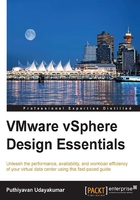
List of challenges and encounters faced on the virtual infrastructure
In this section, we will see a list of challenges and encounters faced with virtual infrastructure due to the simple reason that we fail to capture the functional and non-functional demands of business users, or do not understand the fit-for-purpose concept:
- Resource Estimate Misfire: If you underestimate the amount of memory required up-front, you could change the number of VMs you attempt to run on the VMware ESXi host hardware.
- Resource unavailability: Without capacity management and configuration management, you cannot create dozens or hundreds of VMs on a single host. Some of the VMs could consume all resources, leaving other VMs unknown.
- High utilization: An army of VMs can also throw workflows off-balance due to the complexities they can bring to provisioning and operational tasks.
- Business continuity: Unlike a PC environment, VMs cannot be backed up to an actual hard drive. This is why 80 percent of IT professionals believe that virtualization backup is a great technological challenge.
- Security: More than six out of ten IT professionals believe that data protection is a top technological challenge.
- Backward compatibility: This is especially challenging for certain apps and systems that are dependent on legacy systems.
- Monitoring performance: Unlike physical servers, you cannot monitor the performance of VMs with common hardware resources such as CPU, memory, and storage.
- Restriction of licensing: Before you install software on virtual machines, read the license agreements; they might not support this; hence, by hosting on VMs, you might violate the agreement.
- Sizing the database and mailbox: Proper sizing of databases and mailboxes is really critical to the organization's communication systems and for applications.
- Poor design of storage and network: A poor storage design or a networking design resulting from a failure to properly involve the required teams within an organization is a sure-fire way to ensure that this design isn't successful.
Planning, designing, and positioning a virtualization-based infrastructure are really difficult tasks. There are sizable technical hurdles for administrators to jump, but often it's the challenge of getting everyone to pull in the same direction that ultimately slows a virtualization rollout. Let's explore the top 10 considerations that should be considered before starting to design a VMware virtualization and the best time to start. According to VMware experts, the right stage to start considering, is the beginning, which leads on to the following questions:
- Why is the customer seeking to implement VMware vSphere?
- What applications does the customer plan to deploy?
- What objective does the customer hope to reach with the help of a VMware vSphere deployment?
- What are the existing problems, business or technical, that the customer is trying to resolve?
Requirement gathering and documenting are the driving factors for virtualization; the objectives, problems and needs of the customer should be the first task to undertake before we can start designing. This is the beginning and translates into what we have called the design factors—requirements, constraints, risks, and assumptions. They are crucial to the success of any vSphere design. In the next section, you will learn the ways in which we can overcome the challenges and enforcements.